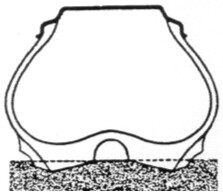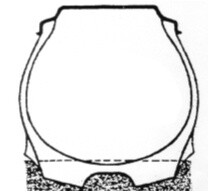
What are the risks of overloading tyres
What are the risks of overloading your tyres and how to avoid it?
You have a lot to think about in your farming business and tyres are not necessarily at the top of your list of concerns. Nevertheless, your tyres play a crucial role in your productivity. Not taking into account their capacities and limits can lead to them being overloaded, resulting in premature wear and unforeseen costs, among other inconveniences. What should you be aware of to avoid this? Our experts explain.
SUMMARY:
What is a tyre overload?
Each tyre has a load rating which corresponds to the maximum load it can carry. But a tyre's high load capacity does not mean it can carry the same load in all conditions. If you drive at too high a speed or don't have sufficient pressure in the tyre, you could find yourself in a situation where the tyre is overloaded.
The load/speed/pressure ratio
These three parameters are closely linked and must be respected to avoid overloading your tyres. For a better understanding, here are two examples with the MICHELIN MACHXBIB tyre size 710/70R42 173D.
Example 1: In this table, we can see that in order to carry a load of 6355 kg, it must not be driven at a speed greater than 50 km/h and its pressure must be 2 bar.

MICHELIN MACHXBIB: load pressure speed ratio
But at a pressure of 1.6 bar, for the same speed, it can only carry 5880 kg. If the tyre were carrying a higher load, it would be suffering from overload.
Example 2: Let's now take the same example, but this time focusing on the speed parameter.
he table shows that if the pressure is adjusted to 1.6 bar, the tyre can carry a load of up to 7380 kg at a maximum speed of 10 km/h.

MICHELIN MACHXBIB: load pressure speed ratio example 2
But if the farm machinery was travelling at 40 km/h instead of 10 km/h, the tyre would no longer be able to carry 7380 kg. Because at this speed, without changing the pressure, its maximum possible load is reduced to 6130 kg.
For ploughing and other agricultural operations requiring high torque, use the 30 km/h line. 10 km/h is for low-torque operations only.
To find out more about load and speed ratings, read our article.
How to estimate your load?
The load on your farm machinery can vary according to its use. Your tractor, for example, may be driven with implements, which may not always be the same.
The big difficulty lies in estimating the load your machinery has to carry in each case.
To help you, Michelin has developed a tool called MICHELIN AGROPRESSURE which calculates the load and pressure resulting from your use.
The importance of pressure
Depending on the load represented by the implement to be towed, the tyres must be inflated to the appropriate pressure, without exceeding the corresponding maximum speed.
And if the load becomes heavier?
If the tool is heavier, you need more air to carry it, simply because what carries the load is the amount of air you put in the tyre.
There are several options to increase the amount of air:
- By inflating the tyres more (our first example showed that at 2 bar the tyre could carry a heavier load than at 1.6 bar)
- By fitting wider tyres
- By fitting wider and higher tyres (with a larger diameter)
So, when it comes to choosing tyres, it's best to choose those that can carry the load your farm machinery will have to carry, or those that can operate at a lower pressure for a given load. Contact your local Michelin agricultural specialist if you are wanting more advice on fitting wider or larger diameter tyres.
An interesting option for increasing load capacity is to fit IF (Improved Flexion) /VF (Very High Flexion) tyres.
Our VF (Very High Flexion) tyres thanks to MICHELIN Ultraflex technology, provide a 20 to 40% increase in load capacity compared with a standard conventional tyre.*
What are the risks of incorrect pressure?
If your pressure is not adjusted when you change your implement, there is a risk that it will not be set up correctly for the load/pressure/speed ratio, as we have seen in our examples above. And this can have negative consequences for your business.
In the field
In the field, incorrect pressure implies different risks, depending on whether the pressure is too low or too high.
Under-inflated tyres
In the field, one of the consequences of insufficient pressure is a loss of efficiency for your farm machinery.
The other consequence concerns the tyre's endurance: an under-inflated tyre will be subject to carcass degradation, leading to shortened life and therefore premature replacement costs.

field low pressure
Over-inflated tyres
An over-inflated tyre in the field is exposed to different risks. It will be more sensitive to cuts and punctures, implying a higher risk of a flat tyre, which in turn will lead to the same concerns as mentioned above (premature replacement costs).
In addition, over-inflated tyres result in a smaller footprint on the ground.
Finally, they lead to a loss of traction resulting in excessive slippage which, besides increasing compaction, reduces tractor efficiency and increases fuel consumption.

field high pressure
On the road
On the road too, driving with the wrong tyre pressure exposes you to different risks, depending on whether it is below or above the one recommended.
Under-inflated tyres
If your tyres are under-inflated for the load they have to carry at the maximum speed you will be driving at, they will be subject to increased shoulder wear, carcass degradation and rolling instability that could compromise your safety.
What's more, under-inflated tyres on the road mean higher fuel consumption and therefore additional costs.

field low pressure on the road
Over-inflated tyres
Over-inflated tyres become bulged, resulting in increased wear not at the shoulders but at the centre of the rolling area.
They are also more susceptible to cuts and punctures, and are less comfortable to drive on.

Over-inflated tyre on the road
Conclusion
It is therefore important to respect the recommended tyre load/speed/pressure ratio.
In the field, a tyre adapted to the load and inflated to the correct pressure will not be overloaded and will have an optimum contact surface and correct stud penetration into the soil. It will be capable of delivering the performance for which it is designed and will have a normal life span.
On the road, a tyre adapted to the load and inflated to the right pressure will not be overloaded and will ensure optimum comfort and safety. Wear will be normal and regular.
Useful links:
MICHELIN UltraFlex Technology
Gain 20 to 40% more load capacity than a standard conventional tyre.*
Our online free tool to calculate your load and pressure
Other articles to find out more:
Need more advice? Discover our tyre damage and wear guide
* Compared to non VF (Very High Flexion) tyre






